What is the best primer for painting plastic or metal miniatures? It depends! Some primers work best on plastic, whereas other primers work best on metals. In principle all primers act as a preparatory coat to prevent the absorption of overlying layers of model paint. The ideal miniature primers are spray or brush-on primers that smooth surface imperfections without obscuring desirable model detail.
In this article, I review the best 10 primers for miniatures and models. I also share tips and tricks for achieving the best results with these primers on metal, plastic, and resin miniatures.
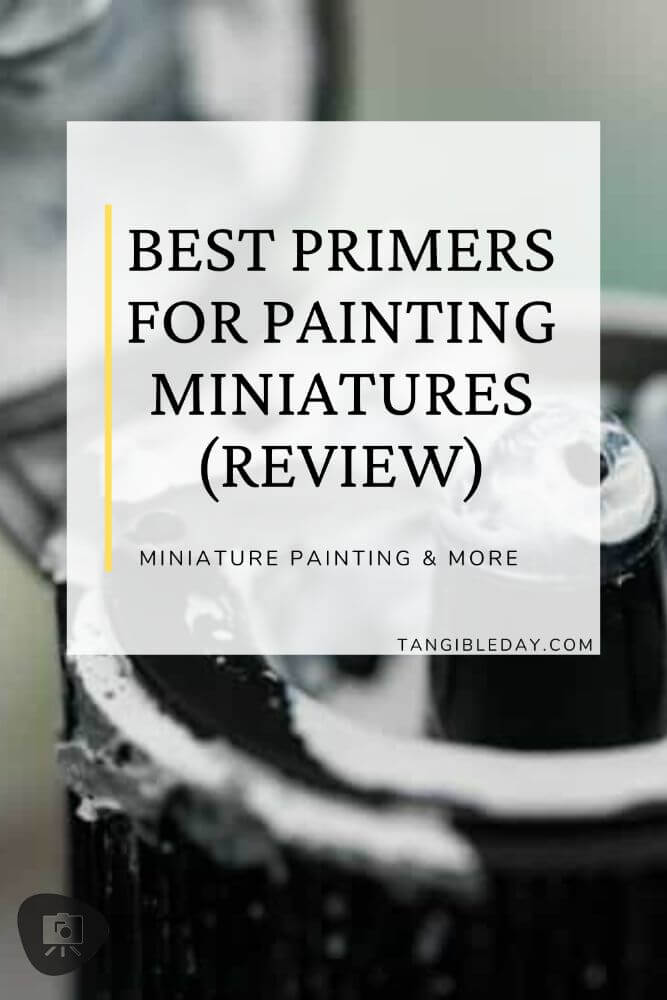
Key takeaways
- Primer smooths model surfaces without hiding details
- Black primers suit quick, tabletop-level painting
- White primers enhance contrast, easing high-standard painting
- Gray primers offer a neutral base, ideal for vibrant colors; they’re a versatile choice
- Aerosol primers are an effective alternative but require caution due to temperature sensitivity, harmful fumes, and the need for good ventilation
Every primer has its advantages and limitations; each has a purpose. However, they all share a common objective: to establish a foundational undercoat that enhances the adhesion and durability of overlying paint layers.
Top 10 BEST primers for painting miniatures and Models
- Citadel Model Primer
- Citadel Paint Contrast Spray: Grey Seer
- Krylon Ultraflat Primer
- Liquitex Neutral Gray Gesso
- Army Painter Primer
- Vallejo Surface Primer
- Tamiya Surface Primer Spray
- Testors Enamel Primer
- Badger Airbrush Primer (Stynlrez)
- Rust-Oleum Automotive Primer
Continue reading for a complete guide about primers and the full review.
What is the Best “overall” Primer for Miniatures?
Vallejo Surface Primer excels as a foundation layer for painting miniatures made of plastic, metal, or resin. I’ve used this primer for years, applying it with either a regular brush or airbrush. In either case, it helps paint “stick” to a model and I’ve never had an issue with peeling, cracking, or other issues durability issues.
Vallejo primer is also inexpensive with a single 200ml bottle lasting hundreds of miniature/model paint jobs. I highly recommend Vallejo Surface Primer for both beginners and experienced miniature painters.
AK Interactive or Badger’s Stynylrez Primers are popular alternatives to Vallejo branded primers. Both AK Interactive and Badger surface primers are airbrush-ready with a bit of water thinning (start with a 1:1 ratio and a 20-30psi in your airbrush). You can also apply these primers to your models with a regular brush. If you don’t have an airbrush, I would suggest taking a closer look at Tamiya Surface Black and White Primer aerosol primers.

Do You Need A Primer?
A primer is an undercoat you use to prepare a surface for paint. Primers create the foundation on a surface that smooths out imperfections, creates an even undertone, and helps overlying paint adhere to the surface. A good primer will also prevent paint colors from peeling and chipping off a model.
I use many brands of miniature paints for my work, e.g., Scalecolor 75, Citadel, Master Reaper Series, P3, Badger paints, Vallejo Model Air and Game Color, but only keep a few kinds of primers on-hand. In comparing different primers to paint miniatures and models, you might be wondering why you need a primer.
Well, for starters, a smooth primer coat is an essential skill to improve your miniature painting.
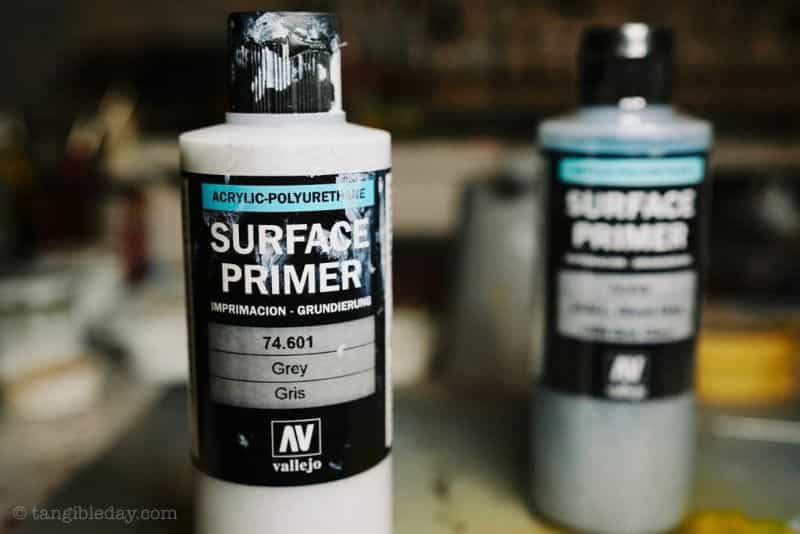
It doesn’t matter if you’re painting on plastic, metal, or resin miniatures, a primer coat provides a universal surface for you to work on.
One of the most visible ways that primers do this is by smoothing out the texture of a surface. Almost all primers have a matte finish when dry, which gives overlying paint a texture to stick to. A flat finish helps prevent peeling, chipping, and improves the durability of your paint job.
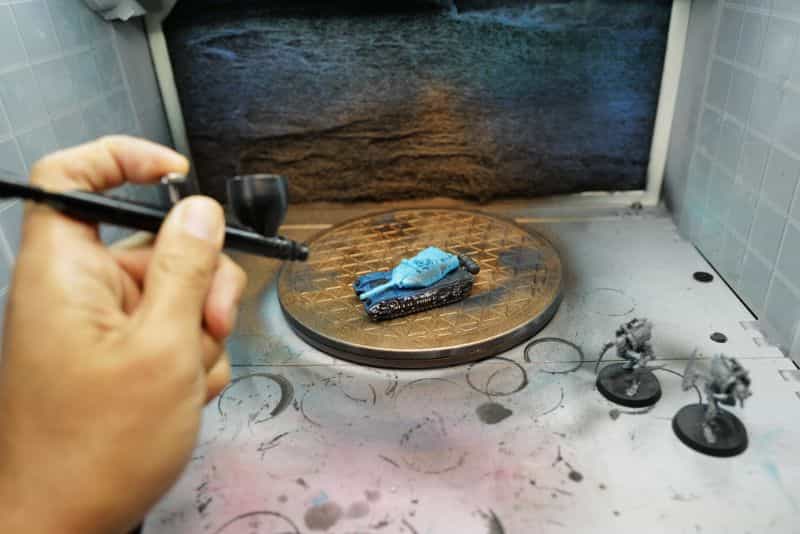
Finally, a primer collectively works to give you more control over how paint flows and behaves on a miniature’s surface. Whether you’re using acrylic or oil paints on a miniature, a primer works to provide you with a foundation for your best work.

Painting miniatures with Army Painter paints or other hobby acrylic paints? Use a primer first.
The “Acrylic Paint Sandwich”: Why You Need to Prime Your Models
Primers aren’t formulated like miniature paints, which are generally acrylic polymer water-based mediums. In contrast to acrylic paint, primers do not absorb water after they dry. This makes primers a key element in a durable paint job for models or miniatures.
The best practice for painting a miniature requires that you “sandwich” your acrylic paint between a primer and varnish. An acrylic layer of paint can absorb moisture, which can lead to subtle warping and expansion of the paint. Hence, you also should use a good varnish seal to protect your models when you finish painting (see more info about best uses for varnishes and my thoughts here).

The best practice for painting a miniature requires that you “sandwich” your acrylic paint between a primer and varnish. In this scenario, your paint job is protected from being absorbed into the model’s surface (if it is porous, some resins for example), and from external insults from the environment, e.g., your hand touching the model during normal handling or tabletop gameplay.
Best Primer for Plastic Miniatures?
The best primers for plastic miniatures in the 28-35mm scale are spray primers. These include aerosol or rattle can primers, e.g., when you shake a rattle spray can, agitator beads inside the metal container makes a “rattle” sound. You know you’ve shaken the primer spray can vigorously and long enough when your hear the rattle sound for at least 30-60 seconds.
Note that the application tips for using primer for plastic also apply for resin miniatures. For larger miniatures, you can use almost any kind of primer, even automotive primers, as you’ll see why below.
Ultimately, the purpose of a primer is to provide a thin even surface in preparation for paint.
READ MORE: BEST HOBBY PAINT SHAKER AND MIXERS
You want to avoid obscuring details with your primer application. This means you want the first layers of the primer coat to be super thin. Each layer of primer coat you apply to a plastic miniature will slowly build up in the recesses. A thin coat will help you avoid unnecessary build up of primer.
In short, more coats of thinly applied primer is better than single, thick layers.
You want to be careful in choosing a primer that you can apply thinly on your plastic miniatures. For smooth surfaces, a thick or thin coat of primer won’t matter as much. But for anything other than a smooth surface on a model, a thin primer layer is your goal.
A spray primer is the best choice, since spraying is the easiest way to apply thin layers over a model. Spraying also prevents bubbles from forming on the surface of your models.
Note: Spray primers are not the same as spray paints. Primers are a special kind of paint specifically made to help the finish coat of paint stick longer and resist weathering. A spray paint, on the other hand, is often just a colorizing product for painting a surface.
RELATED: RECOMMENDED SPRAY PRIMERS FOR PAINTING MINIATURES AND WARGAME MODELS
When using spray primer, make sure to use it in a well-ventilated area and always follow the manufacturer’s instructions. It should be applied with a light mist when priming metal or wood surfaces; too much will cause bubbling or cracking on the surface. When using spray prime
Also, take into consideration that some spray primers require sanding before you can apply your finish coat, e.g., a clear sealant. Make sure to read through the instructions for your primer and prep accordingly
For example, Tamiya makes a rattle can primer for miniatures that is highly popular for professional and competitive miniature painters. Vallejo makes a great surface primer (my favorite) that you can either brush-on or use with an airbrush.
Note that there are times when you want a brush-on primer (more about this below). For example, when you have limited space for a spray booth, indoors in an enclosed space, or in a public convention where spraying might not be appropriate. Aerosol or rattle can primers also pose an issue because of the odors and potentially harmful vapors. These should be generally used outdoors (in low humidity for best results!)
How About Metal Miniatures?
Similar to primers for plastic miniatures, the best primers are those that you apply using a spray application. This provides the thinnest, most even coats on your models. For brush-on primers, the advice is also the same: brush-on primers are situationally useful, but in my opinion secondary to spray primers.
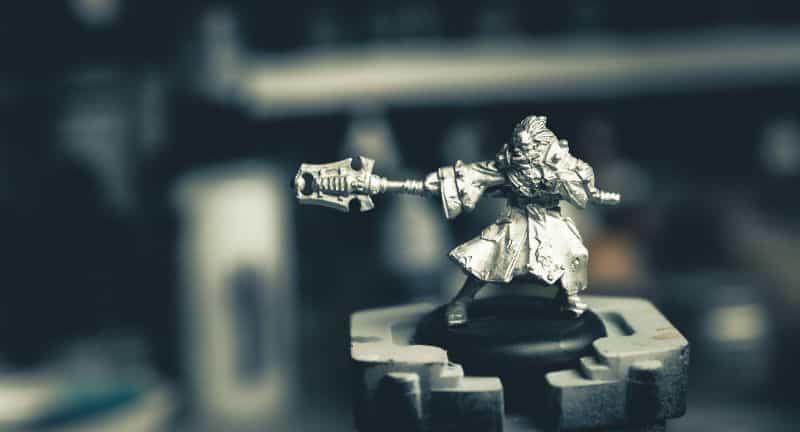
There are two reasons why you may have more trouble priming metal and resin:
- Metal and resin miniatures may have a greasy, mold-release substance on them that repels primer and paint from sticking.
- Metal and to a lesser extent resin models are prone to scratches and deeper bumps, because their surfaces aren’t as flexible.
1. Metal and pewter miniatures are cast in molds with lubricants (oily substance)
Additionally, the lubricant also repels glues, too (you can read more about how to resolve issues with glues and adhesives here). So, this may even be why you are having a hard time assembling pewter models. Glue doesn’t adhere well to that residue of mold-release.
The solution here is to wash your metal and resin miniatures with soap and warm water. Personally, when I have a lot of models or miniatures to wash in this manner I use an ultrasonic cleaner filled with soapy water (see my article on cool ultrasonic cleaners, which I also happen to use for cleaning my airbrushes). You should apply a primer only after washing and drying your models.
2. Paint and primer on metal miniatures tend to get scratched
This seems obvious because metal miniatures are a much harder surface. Metal and resin models don’t have as much flexibility as hard plastic models. The best primers for plastic miniatures, such as those from Games Workshop Citadel miniature lines, may not be the best for metal surfaces.
For metal miniatures, you want a primer that hardens and for lack of better words, “sticks better” to the metal or resin surface. This means you probably want an enamel-based primer. Enamel is a much harder substance than the polyurethane material of a lot of non-rattle can primers.
The best enamel based primers are those in rattle spray cans (aerosol based primers). The best primers for metal models include the Tamiya Surface Primer and Testors Enamel Primer. To my knowledge, I don’t know if there is an airbrush ready enamel-based primer designed for miniatures. The best airbrush primers for miniatures are polyurethane water-soluble solutions.
An Alternative to Enamel-Based Spray Primers is Gesso
Gesso is especially useful for metal or resin miniatures.
Here’s why: Gesso is a hard compound, usually plaster or glue-based, that is traditionally used on canvas, or stone and ceramic sculptures, before painting. It effectively forms a hardened surface with the model you’re working on.
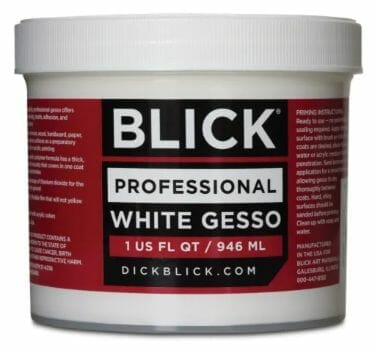
In some cases, Gesso has rougher texture to it, or ‘tooth’, that is useful for some characterful types of miniature painting. If you paint models or miniatures with oil paints, you’ll see Gesso as especially useful.
Should You Use Gesso for Priming Miniatures?
Gesso is inexpensive, forms a protective surface for applying paint, and smooths out surface imperfections. Gesso comes in many forms, but they are all brush-on type primers. Many miniature painters use gesso for priming miniatures and models.
Liquitex Gray Gesso is my preferred gesso medium for priming larger models and terrain pieces. Not only is it inexpensive, it is resilient to scratches and stretches out as it dries on models, providing a very smooth and pleasant surface to work on.
Finally, a good reason to use gesso as your primer for painting miniatures is if you use oil paints. Gesso creates a more absorbent surface than typical primers, which is helpful for toning the model’s surface and allowing those first “lean” oil layers stick. Read more about painting miniatures with oil paints here.
| Image | Product | Useful Info |
|---|---|---|
 | Liquitex Basics Acrylic Gesso | A ready-mixed painting ground, Liquitex Gesso can be used with any kind of paint. It covers in one coat and remains brilliantly white, flexible, and non-cracking. Gesso provides the perfect "tooth" and adhesion to a wide variety of supports and surfaces. |
 | Golden Acrylic Gesso | Golden Gesso is ready-to-use liquid grounds formulated for the use of acrylics on any commonly used painting surface. They are flexible and can be applied in thin layers to conform to a variety of textured surfaces without cracking. |
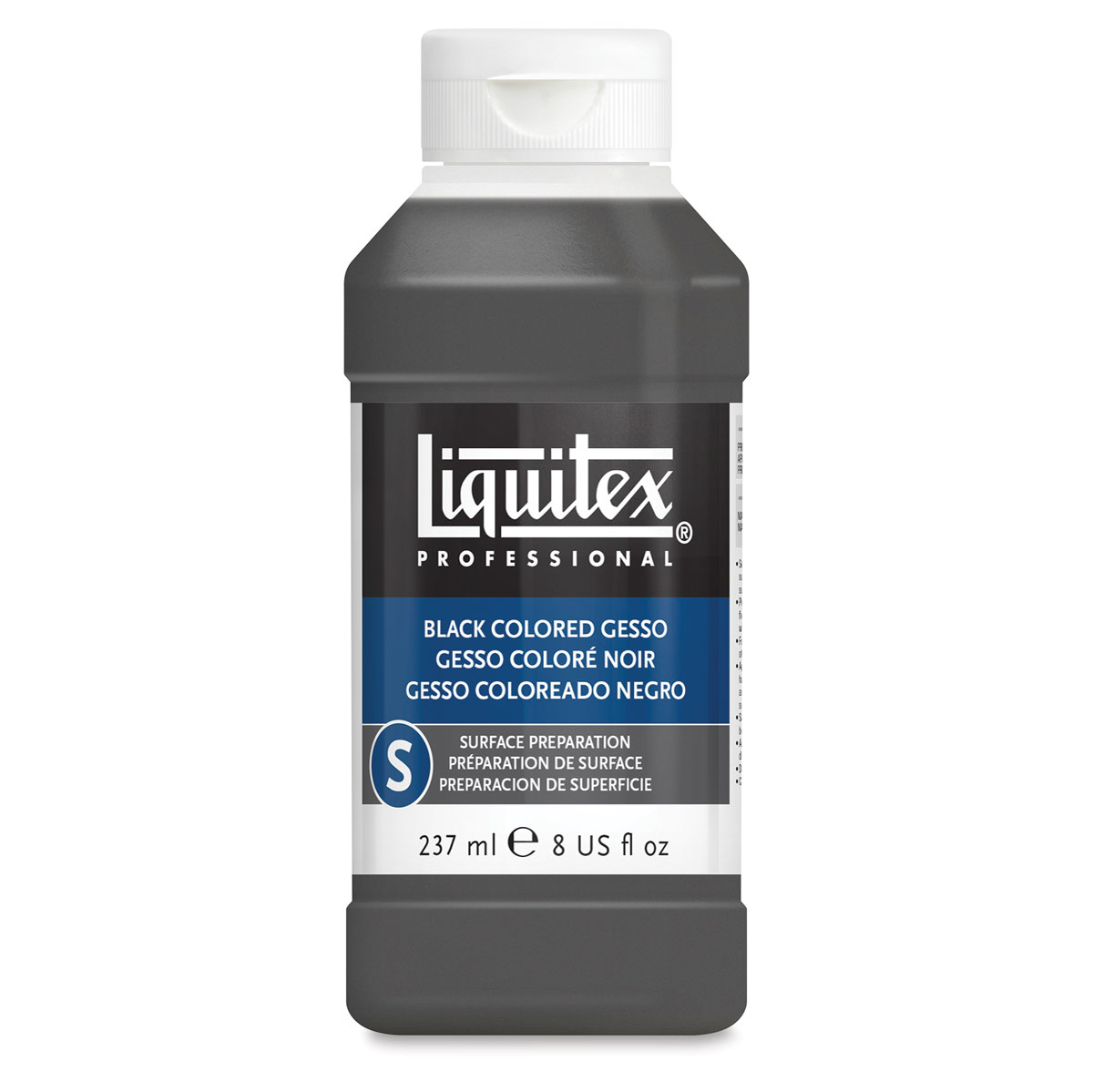 | Liquitex Acrylic Gessos | A ready-mixed painting ground, Liquitex Gray Gesso can be used with any kind of paint. It covers in one coat and remains brilliantly gray, flexible, and non-cracking. |
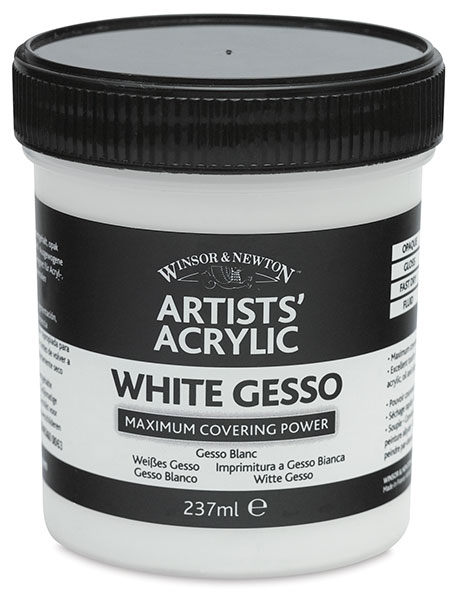 | Winsor & Newton Artists' Acrylic Gesso | Use Winsor & Newton Artists' Acrylic Gesso to prime surfaces and provide "tooth" for good adhesion of acrylics and oils. This gesso offers a balanced absorbency and dries completely clear. |
REcommended Cheap Primers for Large Miniatures and 3D Printing
For cheap primer for miniatures you can use generic household or automotive primers. I’ve tried regular spray primers for painting outdoor furniture like Krylon and Rust-Oleum primers. They are less expensive and come with a lot more primer for your money.
Be warned, however, that these cheaper primers do not coat as thinly as dedicated hobby primers for modeling. Overuse can obscure fine details on your miniatures. My suggestion when using cheap primers is to start spraying with the nozzle farther from your models and apply multiple thin coats to preserve surface texture and detail.
I’ve had good results with cheaper primers for terrain pieces. Cheap spray primers are especially useful for MDF terrain, laser cut parts and terrain pieces, gaming boards, and 3D printed pieces, e.g., PLA or resin 3D printed pieces, which are larger than smaller scale models.

The nice thing about automotive primers is that they are designed specifically to smooth out imperfections on surfaces. For smoothing out the build-lines in 3D printed models, you can use a sandable 2-in-1 primer and filler. A filler primer is great for 3D prints and large models. After these primers dry, you can sand the automotive primer even out the surface in preparation for paint.
In conjunction for gap filling (see more about gap fillers here), an automotive primer can make a model or miniature resilient to damage because how “sticky” or adhesive it is to the surface.

Be Careful with Cheap Primers
A word of caution about using cheap primers that are not designed for miniature and scale modeling work. Cheaper primers, e.g., automotive or outdoor furniture primers, are formulated to cover surface fast. This means that these primers are created to spray-on in thick layers.
RELATED: TOP 3 COMMON MISTAKES WITH HOBBY PRIMERS AND HOW TO FIX THEM
A single coat of automotive or wood furniture primer, especially aerosol delivered primers, will quickly obscure fine details on a scale model or wargaming miniature.
Although I mentioned this is attribute of cheaper primers is advantageous for 3D prints (which have fine build layer lines you want to hide), or large terrain pieces; for miniatures that have small details, including high resolution resin 3D prints, I would suggest you avoid non-hobby grade primers for miniature painting.
For painting miniatures, choose a primer that you can apply in thin coats. Not only does thinly applying primer help you avoid covering up fine detail, these modeling primers give you a lot of control over how much you want to apply at a time.
Maybe you do want to hide fine scratches, bubbles, or imperfections on your models. Other times you’ll want the finest mist of primer to keep all those beautiful facial lines and wrinkles intact on that 75mm scale resin bust.
Your call. When in doubt, thin your primer (just like you would your paints). Even the best miniature primers require some careful observation and attention to proper application.
Can You Use Colored Primers to Paint Models?
Yes! Some game companies make colored primers that you can use as your basecoat color. For example, you can use a “flesh’ colored primer if most of your model is skin. All you may want to do is use a wash or layering technique to increase the contrast. But, otherwise, a base color primer does most of the miniature painting work for you. Paint the details, add wet transfer decals, and you’re done!
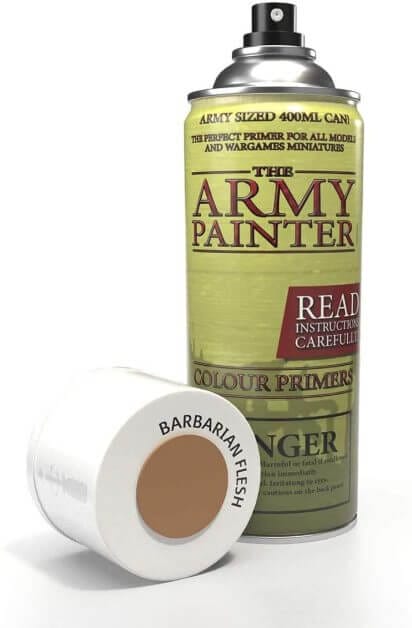
READ MORE: HOW TO SPEED PAINT MINIATURES

Some spray primers from Citadel and Army Painter have colors from the most popular model paint schemes. If you’re painting a company of Warhammer 40k Space Marines in the Ultramarine Chapter, for example, there is a perfectly matched Citadel blue-colored primer you can use to prime and paint your base colors in a single spray session.
Army Painter makes a wide variety of colored primers, too. And, model companies like Vallejo or Tamiya have also been in the business of making color primers specifically formulated for their model kit products.
Are Color Primers Worth It?
Yes, but it depends.
There are two major advantages of a color primer. First, they speed up your paint job by allowing you to base your main color and primer in a single application. All you need to do after spraying your primer is add any details you want. This can be quick or meticulous. Second, a colored primer gives you a jumpstart on an even, smooth surface to work on.
For best results in miniature painting, you’ll always want a smooth coverage with your main base coat. Because you spray-on a colored primer, it’ll be a lot easier for you to achieve the perfect first coat of paint.
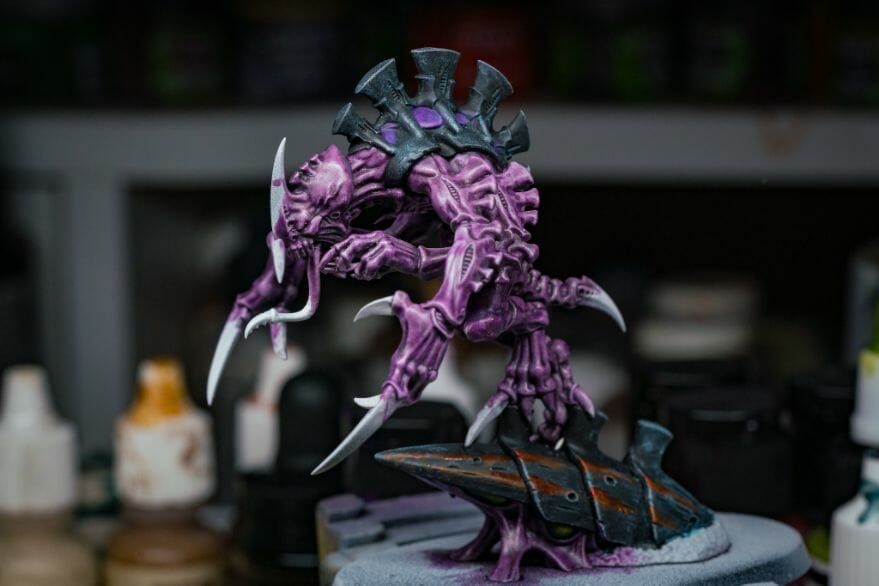
A limitation of colored primers are that they tend to cost more, and you’ll lock yourself into a single color for a lot of models. If you only have a few models you want painted in a single main color, then the cost of the primer may not be worth the time you save.
With a colored primer, you’ll still need to paint the other elements on the model for a decent finish. This means that some of the primer color will be covered by overlying paint. This would remove much of the time-saving benefit of a colored primer.
Ultimately, you’ll want to plan ahead to see if a colored primer will help you. If you paint a lot of models with the same primary color, then using a colored primer will increase your productivity. If you’re only painting a few models, or if the miniatures don’t have a majority of the main color showing, then a colored primer will not be a good investment.
Best Primer Color for Miniatures?
Gray primer is the best overall color. Gray primer is a mix between black and white, providing you with a middle ground color tone to work on when you paint models. You don’t need to plan too much ahead about what models you’ll be painting or how many. Instead, gray gives you a versatile undertone color to paint on.
There is a reason why gray colored palettes (paper or glass) are popular with traditional painters and artists. Gray gives you the ability to discern accurate paint color on a surface while maintaining good contrast (a black primer undertone will hide details).
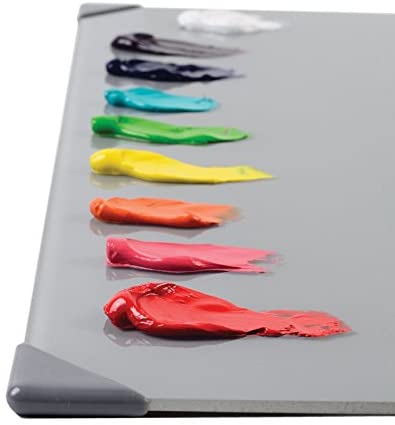
Include Black, White, and Gray Primer in your toolbox
I always recommend having black, white, and gray primers in your painting set. I find black and white primers crucial for various techniques. For instance, in the zenithal priming method, I first apply black primer and then add white from above (e.g., this requires two spray primers). This technique creates a natural interplay of light and shadow on miniatures, perfect for achieving high contrast with glazes.
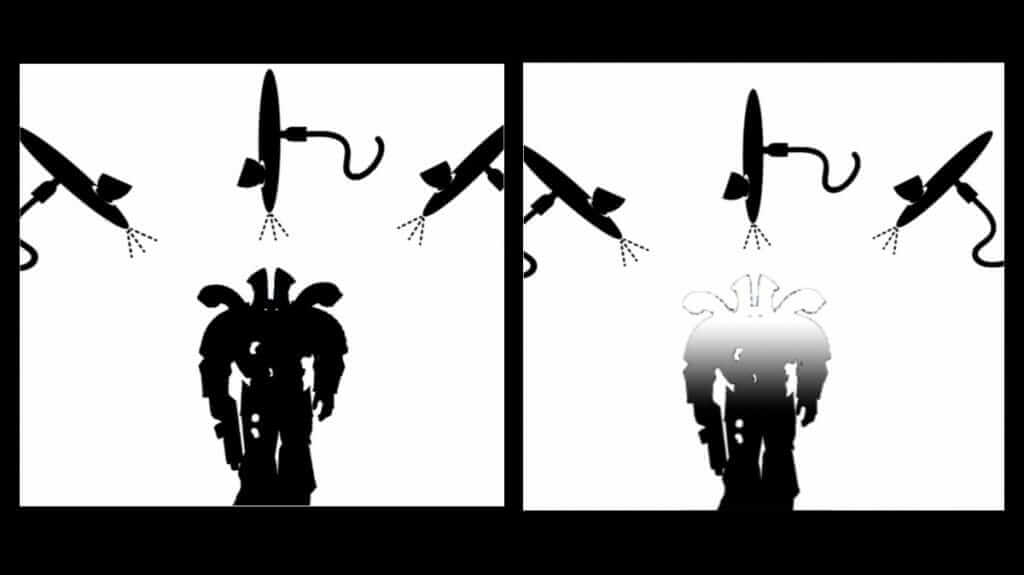
I particularly favor black primer for speed painting. It naturally fills in shadows, allowing me to concentrate on mid-tones and highlights. This is especially useful for techniques like dry brushing or airbrushing, where speed is key.
On the other hand, I use white primer for projects where detail is paramount. It highlights surface details and is excellent for achieving color saturation and contrast, particularly when I’m working with glazes or hobby brand contrast colors. As you turn a model under a hobby lamp, observe how light and shadows play across it. Applying glazes or contrast colors on white primer enhances color saturation predictably.
Ultimately, the choice of using zenithal priming or specific primer colors is a personal one. While some professionals may stick to traditional methods, I appreciate the efficiency of speed painting techniques, including dry brushing and airbrushing, and results that these quick techniques offer.
RELATED: WHAT AN AWARD-WINNING PRO MINIATURE PAINTER THINKS ABOUT THE BEST PRIMER COLOR?
Do You Need to Thin Primers for Miniature Painting?
Most hobby surface primers, like Vallejo surface primer, do not need thinning to work well on miniatures. In fact, over-thinning can make priming more difficult or weaken the primer’s ability to adhere to a model’s surface and overlying paint.
For best results, all you need to do is make sure the primer bottle is shaken well and the primer is free of any floating debris. If you do decide you want to thin your primer, try doing so with water first. Almost all surface primers are water-based and retain their adherence properties when thinned with water.
Finally, if you must use other fluids to thin your primer, do so sparingly. I would only recommend using water-soluble fluids like Isopropyl rubbing alcohol (IPA) to thin surface primer.
Tips for Using an Airbrush with Primers
Airbrushing a primer is a quick way to apply solid, even coats on your models. The simplest way to airbrush a primer is to use an airbrush-ready primer, such as the Badger’s Stynylrez airbrush-ready surface primers or AK Interactive Primer and Microfiller. Simply add a few drops of the primer to your airbrush, set your air pressure to about 25-30 PSI, and spray away. Here’s a quick airbrush priming video showing how this is done.
READ MORE: 6 GREAT PRIMING HACKS YOU WANT TO KNOW
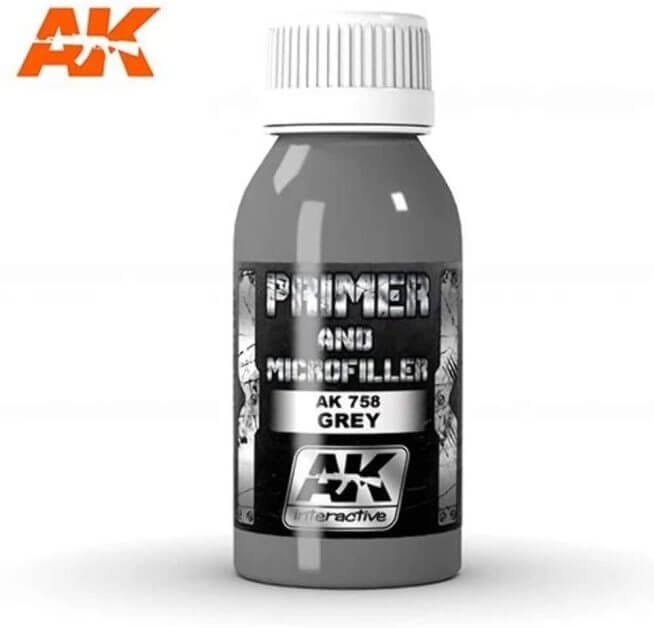
Note that if you’re using an airbrush with a nozzle size of 0.3mm (or smaller), you may want to thin your primers with water or dedicated thinner mediums. Also, for best results and less headaches, make sure you clean your airbrush nozzle after every spray session. Clogs build up quickly, especially with primers (which are extra sticky!).
Airbrush priming is one of my preferred methods for preparing large collections of models for a painting project. The best practice for airbrushing is to thin your paints or primers to the consistency of whole milk. You may need to add several thin layers to properly and evenly coat your models this way.
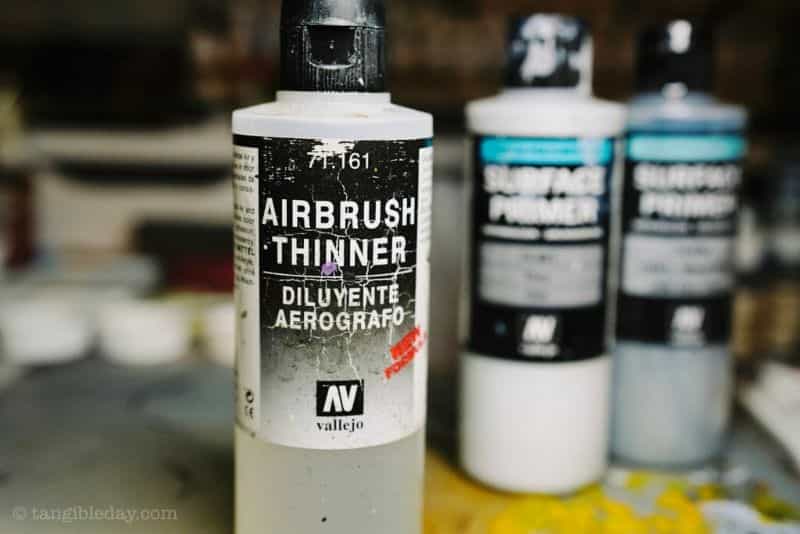
If you don’t have an airbrush-ready primer, you can thin any brush-on primer using the appropriate solvent. In most cases, the proper thinner is simply water (1:1-3 ratio for my needs).
But, if you’re having trouble with using water to thin your primer, you can use an airbrush thinning medium. The one that I use to thin water-based polyurethane surface primers is made by Vallejo. The Vallejo Airbrush Thinner is super versatile, because it is also useful for thinning model paints as well, acting as a flow-improver (check it out here).

Remember, don’t apply too many layers of primer. Each layer slightly removes details from the miniatures. A good rule to follow for spraying primers is to spray in bursts with the nozzle some distance away from the model. Sweep the nozzle spray back and forth so you don’t apply primer on a single area of the model for a prolonged period of time.
Tips for Aerosol Spray Primers
You can follow the same primer application tips as airbrush primer applications.
Spray with your rattle can primer in short bursts, sweeping the nozzle back and forth over your model(s). This prevents the primer from pooling on the surface of the miniature and helps preserve details. Hold the nozzle about 6-12″ away from the miniature while you spray. You’re looking to create a primer “mist” that settles on the model.
Work in layers for maximum effect without losing model details when you’re priming. Allow each primer layer to dry before applying another layer.
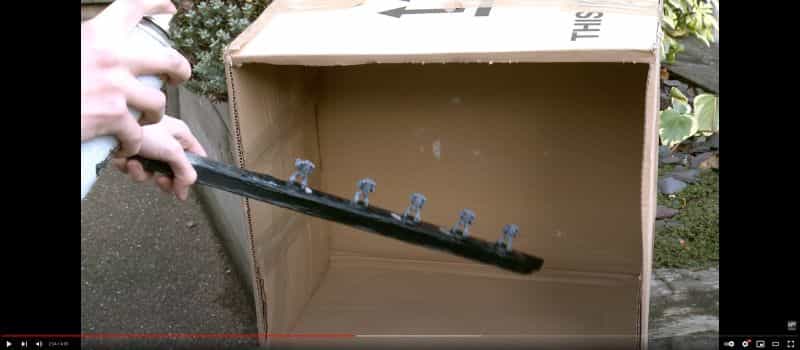
Note that the best temperature to prime miniatures with an aerosol rattle can is about room temperature (75F or 24C). If it is too cold or hot, the aerosol formulation in spray cans won’t mix properly. Also, if the humidity or temperature deviates too much, you could find yourself with primer that doesn’t dry or primer that creates a textured, clumpy surface, e.g., orange peel bumps.
To avoid problems with your aerosol spray primer, don’t prime models in ambient weather that feels too cold or hot for you to wear normal indoor clothing. Also, avoid high humidity conditions which can adversely affect primer from drying properly.
If you really want to continue spraying your primers in uncomfortably hot or cold weather, then the popular suggestion is to use an airbrush with a suitable surface primer. I’ve airbrush primed indoors with great success for many years.
Tips for Brush-On Primers
For brush-on primers, you just need to remember to be patient! Bubbles can form if you try to apply thick layers of brush-on primer. Use a large, flat headed brush and coat in thin layers. I use a cheap synthetic brush for priming and base coating models.
Allow each layer to dry before applying another coat. Sometimes a model might need 2-3 layers of a brush-on primer. It’s okay if you can still see the bare surface of your model under a brush-on primer.
Remember that the primer is simply coating the surface to help prevent your acrylic paint from absorbing into the surface. It’s also smoothing out the surface.
The best thing you can do for any primer application on smaller models is to allow the layer to adhere well. Small details will emerge, even from thicker coats of primer as the solvent evaporates.
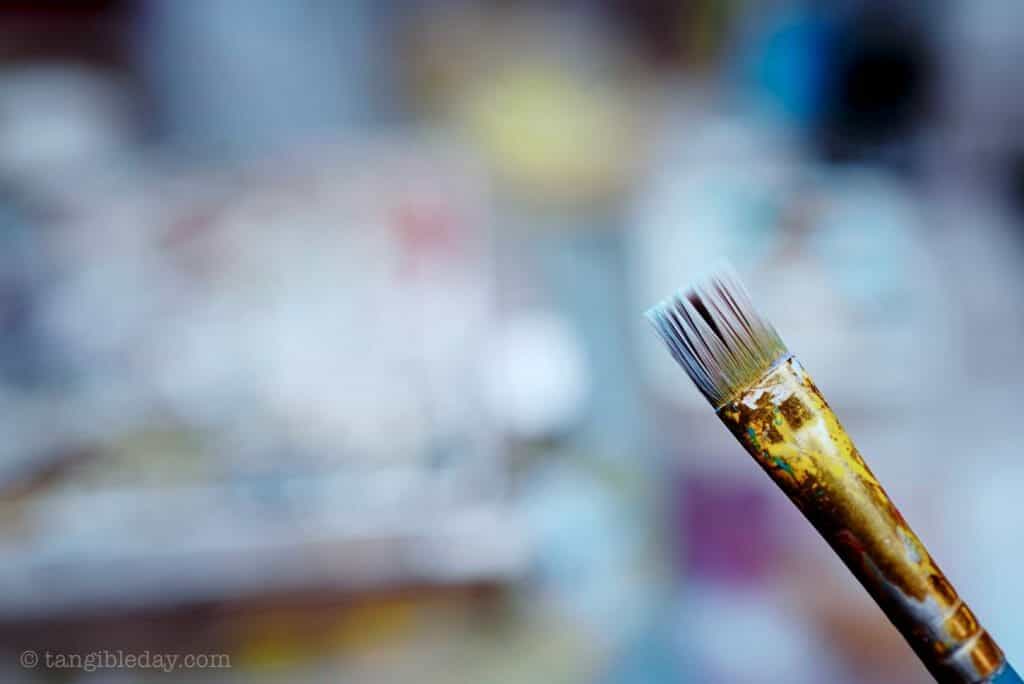
How much primer should I apply to a miniature? You only need a thin layer of primer on miniatures to properly prepare a surface for paint. Good primer is there to help paint stick. Your paint won’t chip with light coats of primer.
The cause of paint chipping is primarily due to the quality of the primer and paint you’re using. If you apply too much primer, then you may lose fine surface details as the primer fills them in.
It takes a bit of skill to properly apply brush on a surface primer, which is why I suggest the best primers for miniatures are those that you can spray onto your models. Overall, take your time when you apply a brush-on surface primer.
10 Best Primers for Painting Miniatures and Models
The following are my recommended 10 best primers for painting plastic, metal, and resin miniatures. As a commissioned miniature painter for years, I’ve dabbled in all sorts of hobby media. Primers have always been an essential product I’ve had to use for every product. Certain primers offer excellent performance but come with a steep price tag. In contrast, some are budget-friendly but require extended drying times or yield inconsistent finishes.
Below, you’ll find the primers I suggest you take a closer look because they are both reliable and won’t break the bank. Finally, it’s important to point out that while some primers come in multiple color options, I’ve specified the ideal starting color based on how well it works.
The Citadel Model Primer is fairly expensive, but it is a good choice if you’re looking for spray-ready primer for plastic miniatures. My experience with this primer for metal and resin miniatures is also very good.
Citadel Model Primer is the most reliable black-colored primer I’ve used for painting wargaming and tabletop miniatures. If you’re judicious, you can undercoat an entire space marine army with a single can.
Make sure you shake the Citadel Black primer spray can thoroughly before use. For best results try to spray this rattle can primer in relatively low humidity at room temperature (25C or 70F).
As an affordable alternative, I recommend Rust-Oleum Flat Black Surface Primer (shown below). The Rust-Oleum Black Primer doesn’t coat as “thinly” as Citadel model primers, so be careful to keep some distance between the nozzle and your miniature when spraying.
Note that there are many colors of Citadel Primer. As mentioned above, each has a purpose. In my opinion, the black primer is the best in terms of quality of the primer surface. It is also useful for most of us who are trying to paint a lot of miniatures in our Citadel model collection. White colored Citadel Primer can be problematic, because I’ve found in my experience that it often leads to a bumpy, powdery surface.
Pros
The Citadel Model Primer is a primer that is useful for plastic and metal miniatures. It is formulated for Games Workshop kits, but can be used on almost any surface material that miniatures and models are made of. Because of it’s branding, this primer is usually found in most hobby or local game stores.
Cons
It’s a rattle can primer. That means it’s an aerosol based spray that should be used in well-ventilated area. For environmental reasons, aerosols aren’t great either. Because the can is under-pressure, you should be aware that storage in a safe place away from heat is important.
As a spray, you’ll also find that a lot of the primer is wasted if you’re not careful to direct it at a fairly large surface area on a model. I suggest spraying more than a single model at a time to make the most use of this primer.
The Citadel Paint Contrast Spray is a primer formulation designed for use along with the Citadel Contrast Paint line. Simply, you apply this to a model as a primer coat. The white color acts as an undercoat for applying the Contrast Paint over it; speeding up the process of painting with Games Workshop model paint colors.
As a primer, it works well and provides a very smooth surface for applying overlying model paints. It’s fairly expensive for a primer, but may be valuable for the Contrast Paint Technique of “one thick coat”. As an alternative to Grey Seer, I’ve found that Vallejo Grey Surface Primer works well with Citadel Contrast Paints. You can see my full review of Vallejo Surface primers for miniatures.
Pros
All the pros of regular Citadel Primer plus the added bonus of combining with Citadel Contrast Paint application. The bright color may also be useful for painting traditionally difficult to paint colors like yellow or orange–colors that have generally poor coverage. A brighter base coat primer can help get those color saturations quicker with less effort.
Cons
Expensive as a primer. As above, it is an aerosol based spray primer and will require proper ventilation for safe use. A respirator mask (organic vapor P95 rated like this) or spray booth could help when you’re spraying in more enclosed areas.
The Krylon Ultraflat Primer, available in various colors, is highly versatile. Neutral gray is recommended for uncertain color choices in miniature painting.
Krylon primer is popular and works really well for both plastic and metal miniatures. It is even good on models made of wood or cardboard surfaces (e.g., MDF terrain) as it seals with a solid coat, filling and sealing off porous surfaces. You can even buy it in multiple colors.
When I first started painting miniatures, I started with primer you can find in hardware stores. Krylon primers are easy to find in local home improvement shops, and I often pick up a can to prime large projects, like my DIY wargaming terrain or large model buildings.
Because it is an indoor/outdoor primer, it is resilient to many insults from the environment. The Krylon primer can therefore provide a solid undercoat foundation for any miniature painting project. The Ultraflat version of this primer is a key feature because it provides some texture for your acrylic paint to adhere. This adds to the durability of your paint job. There is some limitations though to this primer (see below).
Pros
Versatile for many surfaces and resilient to environmental insults. The Ultraflat version provides durability to overlying acrylic paint jobs, by adding surface area to your paint layers. As a primer for miniatures and models, Krylon spray primer is also inexpensive! You can cover a lot of surface area for the cost of this rattle can primer.
Is this the best primer you can use for miniatures? Maybe. As you see below, there are some limitations. In general, I would highly recommend this for larger models and for MDF, laser-cut terrain (which are porous in material nature).
Cons
Although this Krylon Primer is durable, versatile for many surfaces, and inexpensive, it sprays on pretty thick. That means you can easily over spray this primer and obscure details on miniatures. It’ll happen fast if you’re not careful. So, if you use this in small miniatures (29-35mm scale) just be aware and spray from a farther distance.
Gesso is the perfect alternative to normal primers designed for miniatures. Gesso is fairly hard compound formulated with plaster or some type of glue-like substance. Traditionally, gesso is used on canvas an undercoat before painting (with oils or acrylics), or on stone or ceramic sculptures.
Gesso seals off porous surfaces effectively, and forms a solid foundation to apply paint. In miniature and model painting, gesso is particularly useful for metal or resin because of its durability. Liquitex makes an easy-to-dispense bottle of this Gray colored gesso. Other colors are available.
Pros
Great for pewter and resin miniatures. Provides a strong, durable surface. Fairly inexpensive for the amount and how much surface area can be coated. Gesso is versatile. If you’re a traditional painter as well as miniature artist, you can use this for all sorts of projects.
Gesso will help make nearly any surface into a paintable-one with most art mediums (oil- or water-based). Liquitex provides this gesso in one of the thinner viscosity forms. Other brands make gesso that is almost paste-like. The thinner viscosity of the Liquitex version of gesso makes it amiable for preserving the fine details on miniatures.
Cons
Gesso can often be thick. It is best applied with a brush in layers. This means you need to be careful when you want to preserve details on a miniature. Applying gesso can also be difficult because it is prone to making bubbles in the surface. Gesso application requires some patience as it will take a little longer to dry than other primers. I’ve often left gesso on my models to dry for up to 24 hours.
The Army Painter Primer is similar to the Citadel primer (shown above). Army Painter is a modeling company that makes a lot of different products for the miniature hobby. This primer is no exception. It is formulated for all types of miniatures, including those made of plastic and metal.
I know from my community that an Army Painter undercoat is a popular way to start any miniature painting project.
For most hobbyists, this is the best primer because of its accessibility and ease of use: just shake-the-can, hold back a few inches (6-12″), and spray in quick bursts.
Many colors are available from Army Painter for this primer. However, the black colored primer has the best reviews. The white primer seems to cause some individuals some problems with the quality of the final surface. Some of this is due the environmental conditions in which the primer is sprayed. In general, it is best to use rattle can primers in lower humidity and normal room temperatures.
Pros
Easy to find at local hobby shops or game stores. It comes in many colors and functions easily as a spray on primer. It applies thinly when sprayed from a proper distance from the model. In terms of price, it is on par with other competitor products, e.g., Citadel. Overall, it’s a toss up between Army Painter and Citadel branded primers.
As an enamel-based primer it is very useful for a variety of surfaces, forming a durable undercoat layer for subsequent painting. The multiple available colors also make it the best choice for those who want to paint fast, skipping the base coat layers.
Cons
As with other aerosol sprays, it requires a ventilated area for safe use. Aerosols aren’t great for the environment. In general, rattle cans have more limited use than compared with polyurethane-based primers, which come in larger volume bottle for less cost.
The Vallejo Surface Primer sells for $16-20 and worth every penny! This is my favorite primer for most miniature and modeling jobs. I use this as both a brush-on primer or thinned out with water (usually) for use in an airbrush. Here’s in my full in-depth review of the Vallejo Surface Primer applied with an airbrush or a regular brush.
For the price, a single bottle has lasted me hundreds of models. No kidding. As an airbrush-able primer it sprays really well in thin coats. It dries fast and auto-smooths on the surface of both plastic and pewter miniatures. Because of how thin I’m able to apply this primer, it helps retain details while also smoothing out small imperfections.
In some cases, I’ve used this as a brush-on primer for 3D printed pieces. Using this with a brush allows me to apply thicker coats that are useful for hiding print lines in 3D prints.
Most of the models you see on this site were first primed with Vallejo Surface Primer. Vallejo makes this surface primer in many colors, but as with most primers, I prefer to default to gray.
Pros
Works well as both a brush-on or airbrush primer. Auto-smooths as it dries on any surface, including plastic and metal models. I love this stuff. It has easily replaced multiple aerosol spray primer because of how well it coats. A single bottle has lasted me a few months, and I paint a lot!
This Vallejo Surface Primer thins nicely with pure water or Vallejo’s airbrush thinner. Get this primer and give it a try, even if you don’t airbrush it. I’m recommending Gray, but any of the Surface Primer colors are great undercoats.
Cons
The cap dispensing system clogs easily. That’s the only problem I have with this primer: the bottle cap. Other than that, I actually can’t find a weakness in the actual primer itself.
The Tamiya Surface Primer Spray is highly-prized by professional and competitive miniature painters. Tamiya fine surface primer provides a very thin mist that finely coats your models, preserving all the small details. This is especially important for gunpla models, where you need to preserve panel line and rivet details.
Some heavier primers can easily cover these details. As an enamel based primer, it is also durable for plastic and metal miniatures. I’ve recommended the gray color primer as it is the most versatile of the primer colors. But, if you prefer Tamiya makes other colored primers as well, including black and pure white.
Pros
This is the key primer for most miniature artists who take the hobby seriously. The quality of the final undercoat with Tamiya surface primer is top-notch. It sticks nicely to any metal or plastic surface. Details stay put and remain easy to resolve even after a few layers of this primer (shake the can vigorously for best results, and spray in a low humid environment).
I should note that the can is small, which is useful for portability. It will fit into most side bags, or model cases with little trouble. If it wasn’t for the fact that I don’t have much ventilated space for using aerosols (I work in a basement), I would definitely be using this primer more. I really like the neutral gray color!
Cons
There aren’t too many cons with Tamiya’s surface primer. It’s well regarded by the miniature and modeling community. If there’s a knock to this product, it’s the premium price. It’s a small can, and priced at close to the same as the other premium modeling primers out there.
Also, as with any aerosols, you need a good space to safely spray this an avoid the harmful vapors. The warnings about this are all over the can. But, if you want the best primer for miniatures, you should strongly consider Tamiya’s Surface Primer.
The Testors Enamel Primer is a direct competitor of Tamiya’s product. Both are similarly priced with a similar kind of enamel-based formulation for undercoating highly-detailed miniatures and scale models. Everything I said for Tamiya’s primer holds true for Testor’s version.
They are similar on almost every level that I can investigate through online research. For me, Testors is more available in local art supply stores than Tamiya’s product (which is billed as more specialized).
Pros
This is a great spray primer. Useful for any surface and is the best primer for plastic, metal, or resin miniatures. As an enamel-based primer, it forms a solid, smooth undercoat in preparation for modeling paint application. I also like the small can. It makes it easy for me to travel with my painting kit and always have primer with me.
Make sure you shake the can vigorously to mix the primer with the aerosol contents for a proper fine spray. Keep the can more than 6-12 inches away from your working surface of the model. Thin coats should be applied in several layers, waiting for each layer to dry before applying the next. This should only take a few minutes, as this stuff dries fast!
Cons
It stinks literally. Harmful vapors are not friendly to painting in a basement or enclosed area with poor ventilation. Testors enamel primer is a premium product for modeling, and is priced as such. In my opinion, though, Testors spray primer is a solid product (just make sure you shake it well and spray in a preferably cool, low humidity environment).
The Badger Airbrush Primer (Stynlrez) comes in a set of three colors (black, gray, white) and is cheaper as a bundle. It’s a cost-effective, airbrush-ready option with an acrylic-polyurethane formula, creating a tight, auto-smoothing layer on model surfaces. This means that they form a tight, non-porous and auto-smoothing layer directly on the unpainted surface of your models.
This is great, and perhaps this is one of the most under-rated, largely ignored primers on the market. And, I’m not sure why except that maybe these primers are not advertised as much as the others and are fairly new on the market.
Badger is a US based company with a great reputation for their line of airbrushes and accessories.
Pros
Airbrushing primer is the most cost-effective way to applying primer. These make it easy to apply very thin layers of primer easily. Because these are already thinned for your airbrush, you don’t need to do anything except drop them into your airbrush reservoir cup. For the price, these are also the most inexpensive of the modeling primers available right now.
Given their price and the reputation of the Badger company, I would recommend them as the best airbrush ready primer for miniatures. Because of how thin they are, they could also be useful when applied as as a touch-up primer using a brush.
Cons
I’m not a fan of the bottle caps on these Badger paints and primers. The caps tend to clog up, and little drops of liquid dry on the edges of the opening, which makes them hard to close. The Stynlylrez are a somewhat new brand compared to some of the other primers on the list and less well known. So, it may be harder to find more established miniature painters from recommending them.
The Rust-Oleum Automotive Primer is the cheapest spray type primer on this list. I’ve used this automotive primer to great effect on 3D printed parts and larger terrain pieces made of MDF or plastic.
The advantage of an automotive primer is that it is strong. It cures into a very durable surface over which you can paint confidently. Because it also has a subtle gap-filling component, it also helps smooth out layering imperfections, which are a hallmark of fused-deposition modeling (FDM) 3D prints.
Rustoleum primer is also known to protect against environmental exposure, blocking out ambient moisture. This is what gives this primer its anti-rust capability.
For us, this is useful for sealing, protecting, and priming surfaces made of wood, cardboard, or medium density fiber (MDF) pieces. When you paint over this with water-based acrylic paint, you can be sure the paint stays where you put it.
Pros
Super cheap aerosol primer. This is the perfect primer for MDF pieces, such as laser-cut terrain pieces. It seals and protects porous surfaces. For miniatures, automotive primer is perfect for smoothing out imperfections and filling tiny gaps in models or 3D prints. It is also possible to use wet or dry sanding methods to further smooth and prepare a surface for paint.
Because it’s a spray can, you can coat very large surfaces quickly and so this is great for larger models. It’ll work on plastic and metal equally well. My recommendation would be keep the spray can some distance away to ensure you don’t over coat a model and lose details.
Cons
You can easily lose details on small models with an automotive primer like this. It’ll easily obscure things like panel lines, rivets, and small folds in sculpts that are in the 28mm scale. I would only suggest the use of this primer on large models. As with any aerosol, there is also the need for good ventilation.
Many miniature painters attest to the wonder that is the AK Interactive Primer. This primer did not make the main list, however, because it can be difficult to find in local stores or online (at least in my local areas that I’ve searched for).
This primer auto-levels as it dries evening out any small bumps in your model surface. It also sticks really well to any model surface, including plastic, metal, or resin. It can be painted on any surface with a brush or with an airbrush. AK Interactive recommends that you use their thinner.
In general, although hard to find in some countries, and usually with long delivery times, the AK Interactive Primer has some of the best features of my personal favorite Vallejo Surface Primer. Though, I would be careful because it does have a strong odor. If you decide to airbrush AK Interactive primer, I suggest using a filtered spray booth.
Pros
This is a highly recommended all purpose primer. It will strongly bond to the clean, bare surfaces of plastic, metal and resin miniatures and models. AK Interactive is one of the best primers for those looking for a no-nonsense acrylic primer. Due to its formulation, the primer applies easily with a brush or airbrush and creates a smooth and even surface for model paint color.
Cons
As with any primer with filling properties, be careful you don’t over-coat your model. It doesn’t take much primer to effectively cover your model. As mentioned, AK Interactive primer is a little hard to find in the United States. But, if you’re willing to wait for an overseas delivery this may be a great primer for any model you’re preparing to paint.
Summary Table
| Image | Product | Feature | Check Price |
|---|---|---|---|
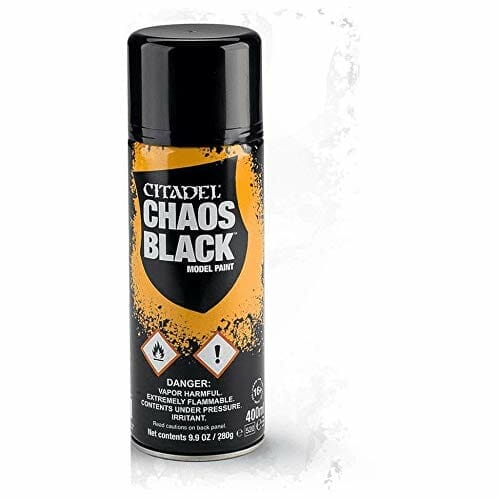 |
Citadel Model Primer | Games Workshop spray primer designed for plastic or metal. Good utility and versatile. Many colors. | Check Price |
 |
Citadel Model Primer | Works similarly to regular Citadel Primer, with added smoothness and brightness for Citadel Contrast Paint. | Check Price |
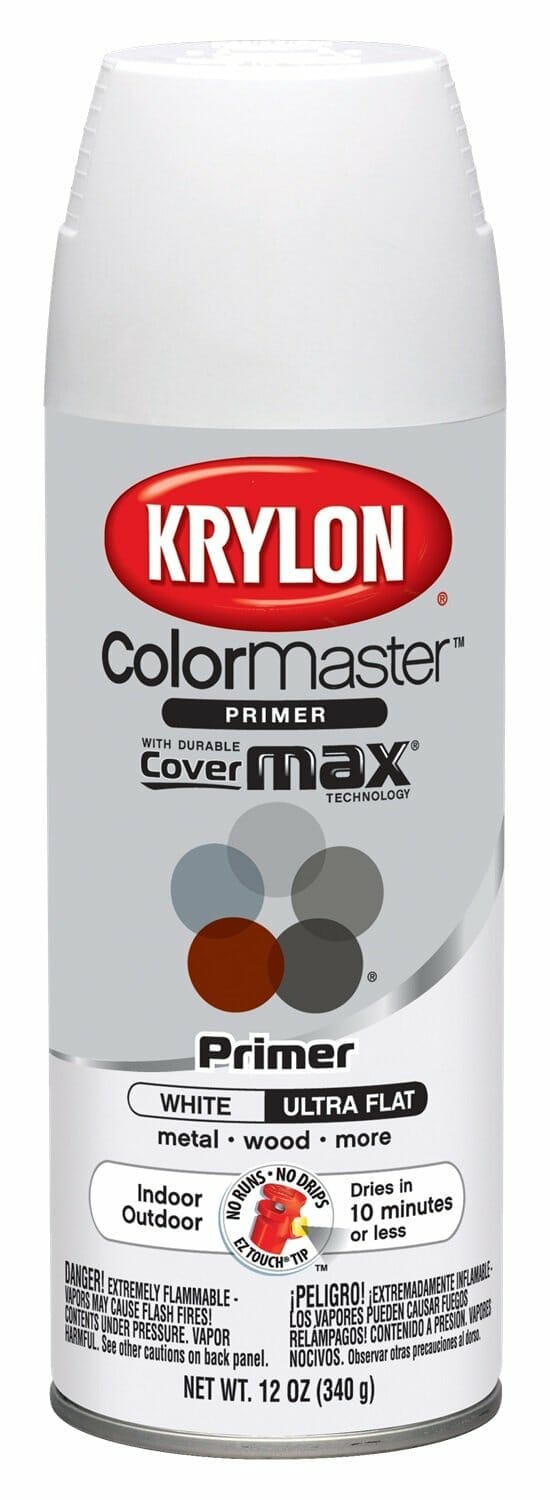 |
Krylon Ultraflat Primer | Versatile, cost-effective, and easy to use. | Check Price |
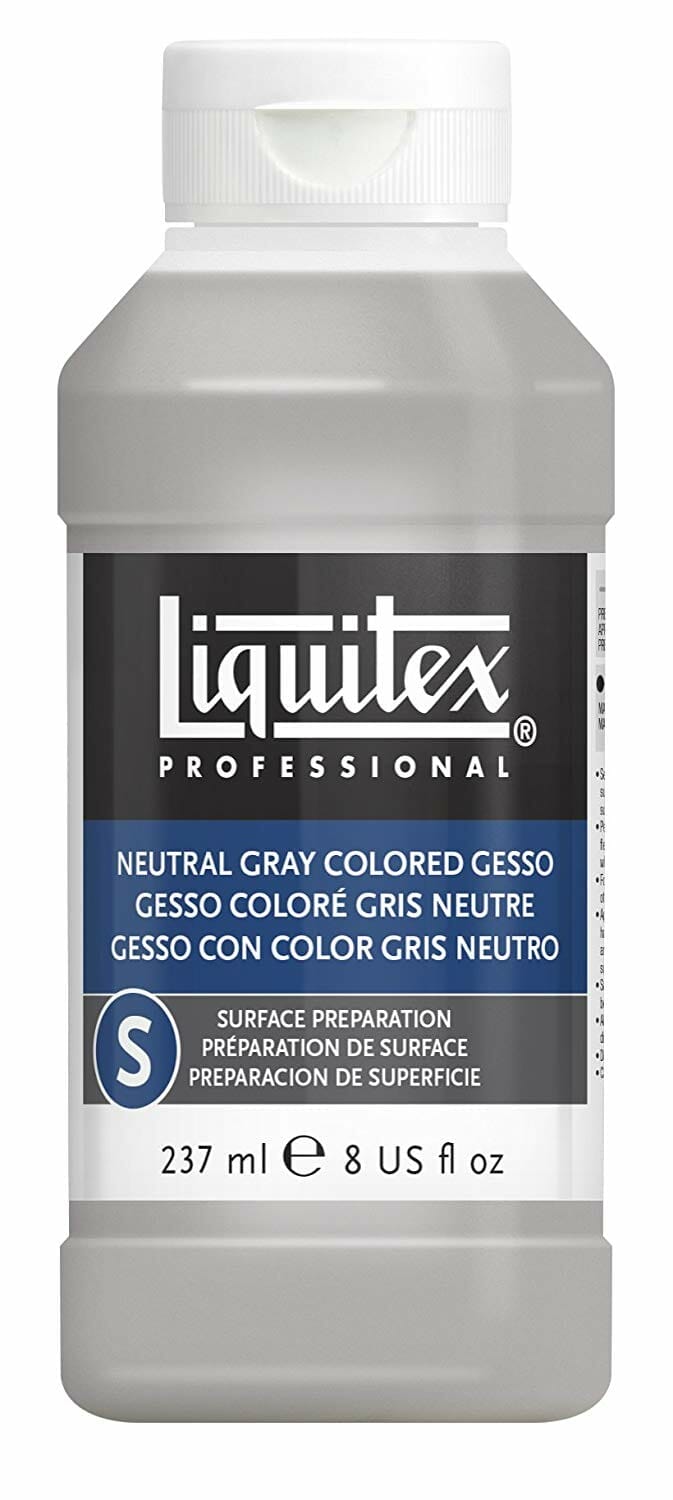 |
Liquitex Neutral Gray Gesso | Gesso is a durable compound that is easily applied with a brush and seals all types of surfaces in preparation for paint, e.g., wood, MDF, plastic, metal. | Check Price |
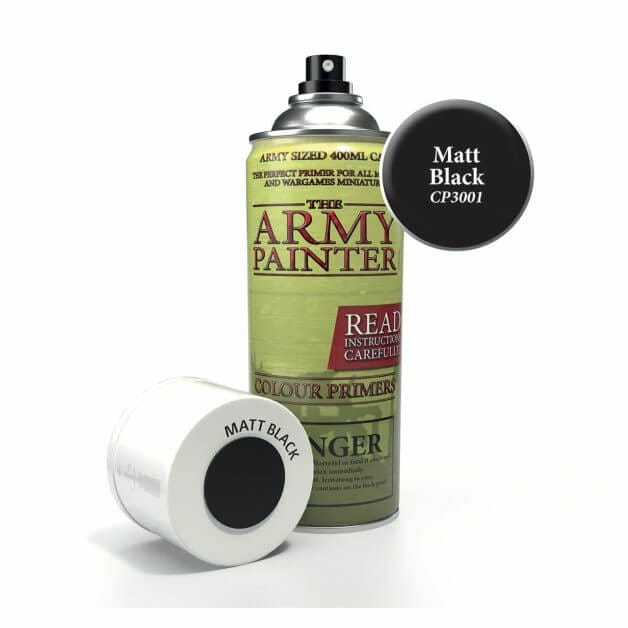 |
Army Painter Primer | The less expensive alternative to Citadel primer, and arguably just as good. | Check Price |
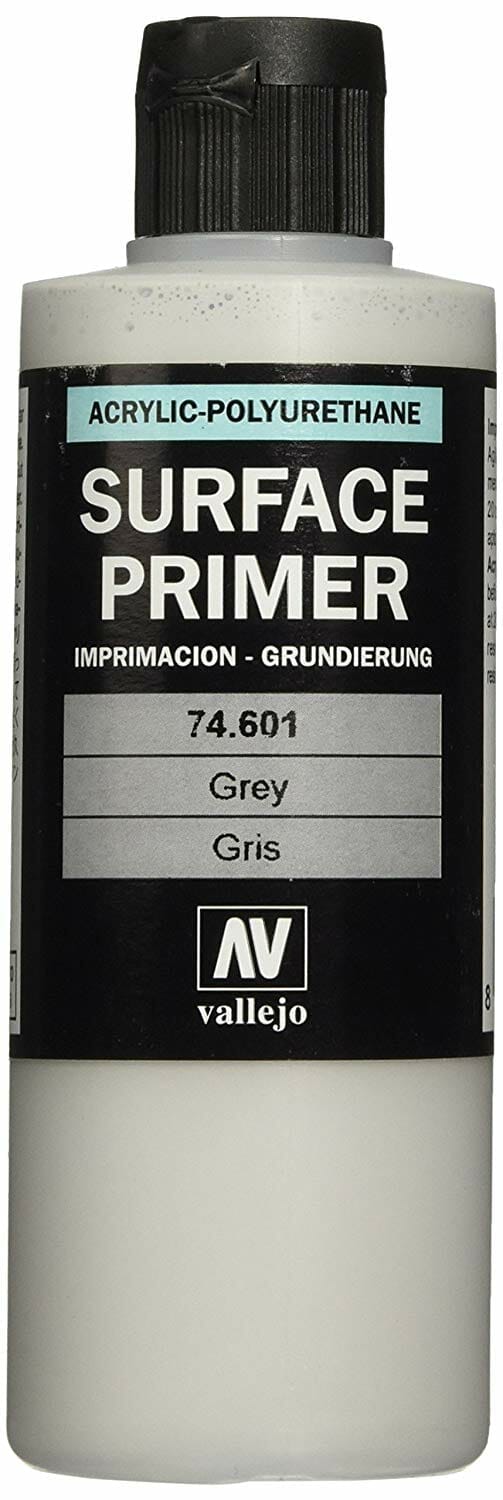 |
Vallejo Surface Primer | This is my favorite primer, hands down. It works on everything I’ve thrown it at, except large MDF terrain. Use a gesso or enamel-based primer instead. | Check Price |
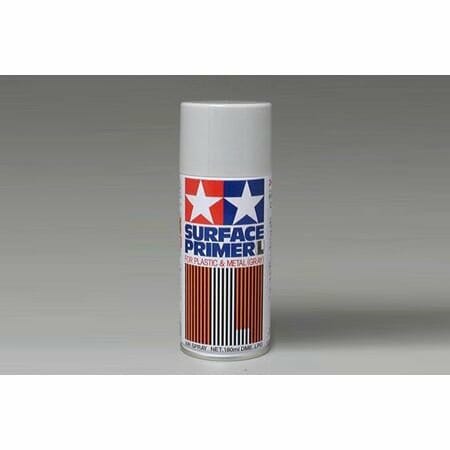 |
Tamiya Surface Primer Spray | A perfect spray enamel primer for all your modeling needs. | Check Price |
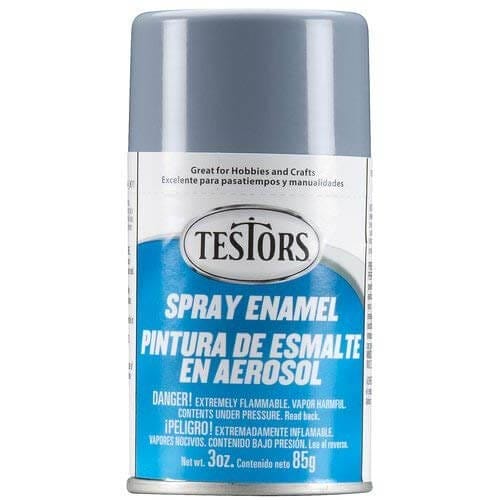 |
Testors Enamel Primer | This is essentially the same as the Tamiya Surface Primer. You can’t go wrong with either of these primers. | Check Price |
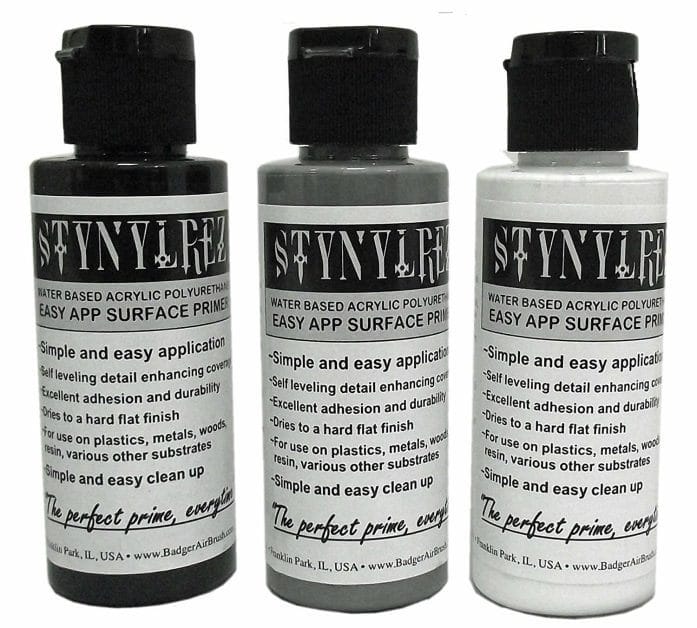 |
Badger Airbrush Primer (Stynlrez) | A cost-effective and airbrush-ready primer for miniatures and models. | Check Price |
 |
Rust-Oleum Automotive Primer | Perfect for large models and 3D prints. Gap filling properties. Wet or dry sand. Inexpensive. | Check Price |
Frequently Asked Questions (FAQ)
What is a primer?
A primer is basically a layer of paint that acts as the first layer on the model or miniature. The primer provides a surface for you to apply your second, third and fourth coats of paint. You can directly apply acrylic or oil paints directly on top of any hobby primer coat on your miniatures. Primers also help to create a surface that the paints bond stronger to rather than just sit on top of the model or miniature. It is not uncommon to prime a miniature twice, especially for metallic paints.
How long does it take for a primer to dry?
It depends on the ambient environment you’re priming your models. Under normal conditions, you can expect most hobby primers to dry completely within 10-30 minutes. For best results, allow your primer to dry before applying any paint. You can use a hair dryer with a low heat setting to speed up the drying process.
What paints work best with primers?
For painting miniatures, you can apply any paint medium on top of a primer coat. Some primers, like gesso, will have a rougher texture which will can help you blend some types of paint, e.g., oils. They also have absorbent qualities that can speed up paint dry time. In general, most miniature painters will use acrylic model paint and apply it directly over a even coat of primer. There are a lot of great brands of acrylic paints that will work well with a hobby primer, including those from Games Workshop/Citadel, Vallejo, The Army Painter, and other hobby game companies.
Do primers work on all kinds of miniature materials?
Miniatures and scale models are often made of plastic, metal, or resin. In some scale model kits, wood is also a part of the construction. The best primers for miniatures are all-purpose primers and will work great on multiple material surfaces. Just keep in mind that you may need to apply multiple coats of your primer depending on the material of your model. For example, you may need additional layers of primer on resin miniatures for a solid coat as compared with metal miniatures where a single primer coat would suffice.
Conclusion
I hope you found this guide and review helpful!
Well, what is the best primer for painting miniatures? That’s really up to you and your particular project. There are a lot of options to choose from and each primer has pros and cons.
This review highlighted the 10 best primers for plastic, metal, and resin miniatures. But, as any hobbyist knows, there is always more than one way to finish a job. Play around, experiment!
For general use in most miniature painting projects, I highly recommend Vallejo Surface Primer. Here’s a more in-depth review and guide for how to use this primer.
Do you have a favorite modeling primer? If I missed any favorites, please let me know!
Happy painting (and priming)!



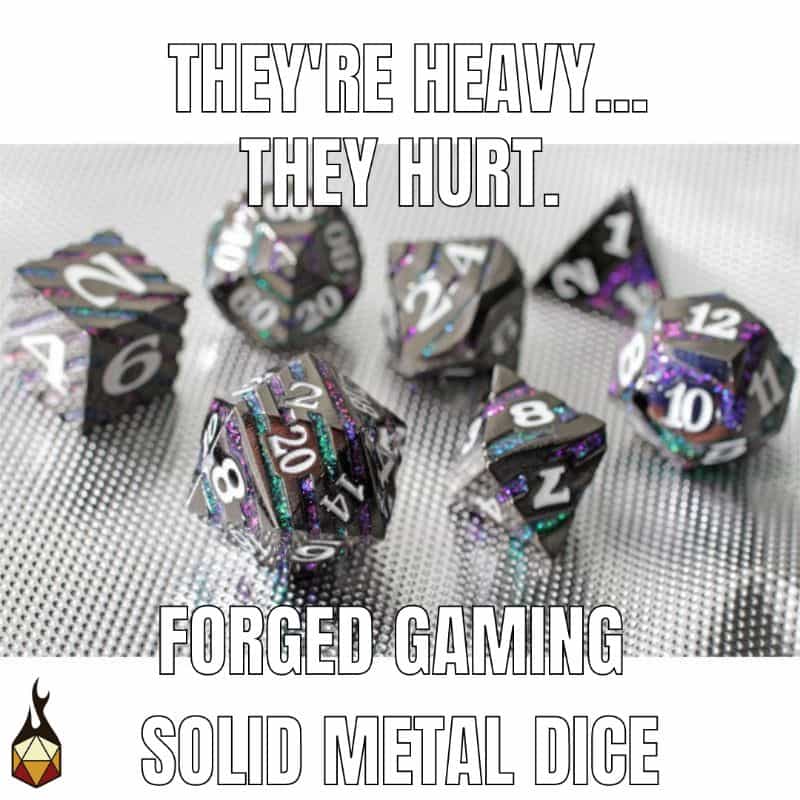


Tangible Day on YouTube (Miniatures and More!)



Tangible Day on YouTube (Miniatures and More!)

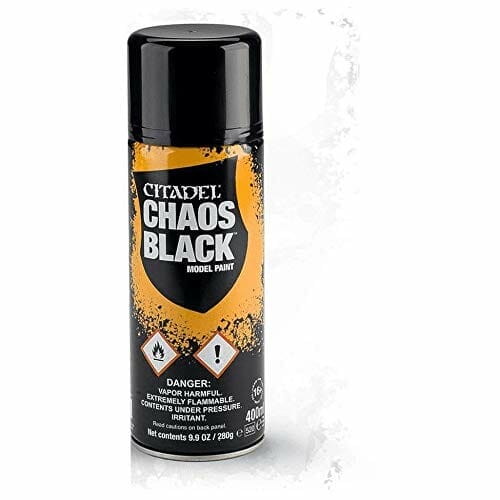








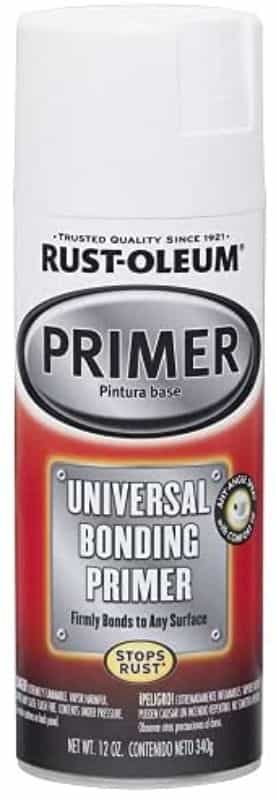

I happened on AK Interactive’s black and white sprays recently. I’ve found them to be the best spray primers I’ve ever encountered, and reasonably priced (just under half the cost of GW’s srays here in AU, same price as Tamiya).
https://azazelx.com/2019/05/12/review-ak-interactive-hobby-sprays-black-primer-white-primer-protective-varnish/
Ah, I will look for it. I haven’t used any AK Interactive products (they can be pricey here)
Pingback: How To Paint Guitar Picks [The Ultimate Guide] – Traveling Guitarist
Thank you for this informative Review! A great help.
Awesome! I appreciate the gracious comment 🙂
Tried Tamiya primer and it did not work well. Trying to use Acrylic paint on top of it had big issues.
Hmm weird. How’s you apply it? If it’s not mixed well before spraying or applied in humid or cold conditions, the primer may not set/cure properly.